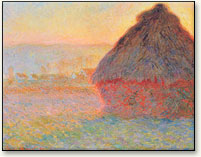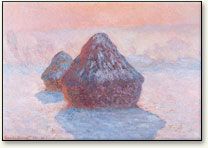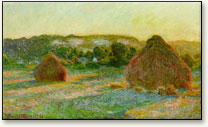Monet's Colors

|
From the Haystack series, |

|
Meule, Effet de Neige, le Matin (Morning Snow Effect), 1891. |

|
From the Haystacks series, |
Until the 19th century, color was thought to be an intrinsic property of an object, like density or melting point. Oranges were intrinsically orange and lemons were intrinsically yellow.
The French Impressionists and post-Impressionists change this conception. Claude Monet’s (1840-1926) work around 1890 demonstrates this development. Monet and his contemporaries begin to paint outdoors, as opposed to the traditional settings of a neutral studio environment. Thus, Monet’s series of haystacks are painted under different light conditions at different times of the day. He would rise before dawn, paint the first canvas for half an hour, by which time the light would have changed. Then he would switch to the second canvas, and so on. The next day he would repeat the process.
In each painting, the color of the haystack is different because the light shining on the haystack is different. The color of the haystack is determined by the colors the haystack absorbs. The color we see is simply the colorized light that is not absorbed and that is reflected into our eyes.